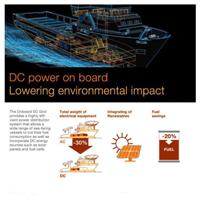ABB Onboard DC Grid Order For Offshore Newbuild
 ABB has won an order from ship owner Myklebusthaug Management to supply their first direct current (DC) power grid solution on a new offshore platform support vessel, enabling the vessel to operate at the highest energy efficiency level to minimise emissions. ABB will provide its full onboard DC system, including all power, propulsion and automation systems for the 93m, 5,000t supply and construction vessel, which is scheduled for delivery in the first quarter of 2013.
ABB has won an order from ship owner Myklebusthaug Management to supply their first direct current (DC) power grid solution on a new offshore platform support vessel, enabling the vessel to operate at the highest energy efficiency level to minimise emissions. ABB will provide its full onboard DC system, including all power, propulsion and automation systems for the 93m, 5,000t supply and construction vessel, which is scheduled for delivery in the first quarter of 2013.
Launched in May 2011, ABB’s Onboard DC Grid is part of a revival of power solutions using DC, and will provide highly efficient power distribution and electric propulsion for a wide range of vessels. It is designed for ships with low-voltage onboard circuits, such as offshore support vessels, tug boats, ferries and yachts, and can reduce fuel consumption and emissions by up to 20%.
Energy Savings
In traditional electrical propulsion vessels, multiple DC connections are made to thrusters and propulsion drives from an alternating current (AC) circuit, accounting for more than 80% of electrical power consumption. ABB’s Onboard DC Grid represents a step forward in optimised propulsion by distributing power through a single DC circuit providing significant power savings.
“With this solution, the vessel will be ready to maximise opportunities in energy savings with supplementary DC energy sources, such as solar panels, fuel cells, or batteries connected directly to the ship’s Onboard DC Grid”, said Veli-Matti Reinikkala, head of ABB’s Process Automation division. “The Onboard DC Grid will help the vessel operate from the very first day at the highest levels of fuel efficiency with low emissions.”
Key Advantage
A key advantage of ABB’s Onboard DC Grid is that the ship’s engines no longer have to run at a fixed speed, so the engine’s speed can be adjusted to optimise fuel consumption. By eliminating the need for bulky transformers and switchboards, the footprint and weight of the electrical system can be reduced by up to 30%, leaving more space on the vessels for passengers or cargo while also providing greater flexibility in the positioning of system components in the vessel.






